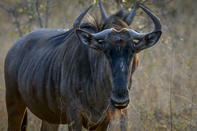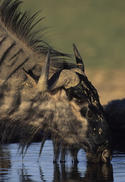The Perfect Lawnmower
The blue wildebeest is also commonly called the ‘brindled gnu’. Its silvery-blue coat is lined with darker bands over the shoulders and flanks, which provide the brindling and the noise that the wildebeest makes sounds like ‘gnuuu’.

Blue wildebeest are pure grazers and selective at that. They do not select for species or specific parts of the plant like other selective feeders but rather wildebeest are ‘site selectors’ and will only take forage 15 cm long or less. In this regard, they trample and maintain their own pastures and their wide muzzles are perfectly adapted to crop the lawn.
Drink Daily

Blue wildebeest feed during the cooler parts of the day and into the night. During the hottest parts of the day they will seek refuge in the shade and if this is not available, they will face into the prevailing breeze and allow the wind to cool the blood flowing through the bosses of their horns.
Wildebeest are very water dependent and they will drink daily even satisfying their thirst on muddied waters (unlike zebra).
In areas where they can no longer migrate to follow seasonal supplies, they will always be within a 15km radius of a permanent water supply.
Wildebeest can be quite influential on ecosystems surrounding water sources and in areas where they have become sedentary because of artificial water supplies they have been known to trample and alter longer grass pastures to the exclusion of long-grass specialists like sable and roan antelope.
By Megan Emmett